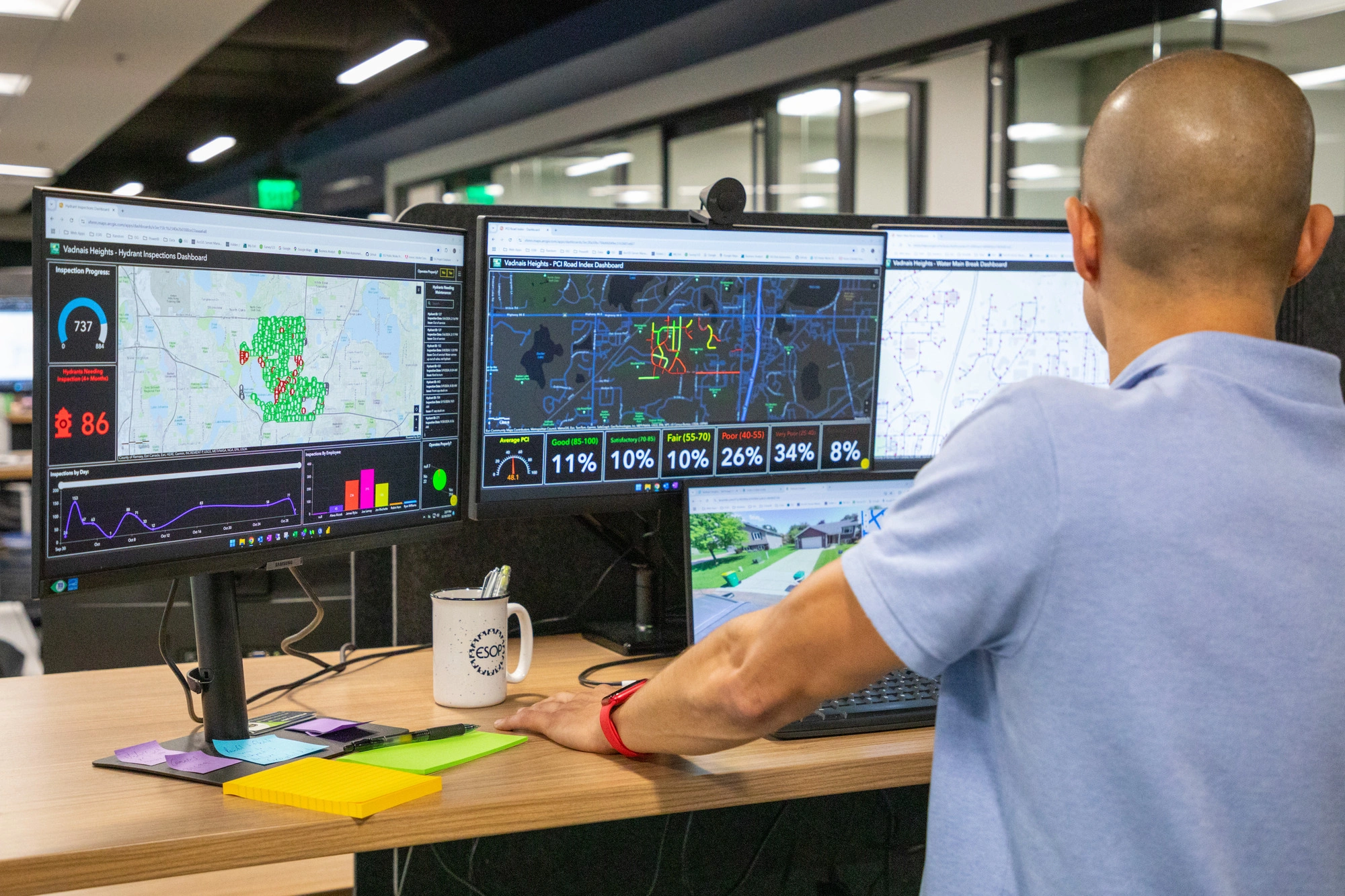Take Action through Stormwater Planning
In the simplest form, stormwater planning involves understanding the impact water runoff and rainfall events will have on your city and its infrastructure. To gain this insight, it is important to have the right resources and tools available to accurately predict how much water runoff will occur throughout the year and where it will go.Projecting where the water will go requires up-to-date terrain details, including topographic maps that identify hills, bodies of water, streets, parks, parking lots, buildings, and other pervious and impervious elements. With modern geographic information systems (GIS), most municipalities have this detailed information readily available, streamlining the first step in the planning process.Quantifying precipitation volumes and rates is a bit more challenging. Forecasts, precipitation averages, and other scientific weather data are useful, however with changing weather patterns—including increasingly intense weather and heavier rain patterns—there is a necessity to incorporate forward-looking data into planning.Adding to the stormwater challenges cities face due to changing weather patterns, many have infrastructure that was constructed in the post-industrial era. While this infrastructure is often insufficient to provide an acceptable level of service, it is also cost prohibitive to completely rebuild existing infrastructure.Making incremental improvements is often the best way to balance flood mitigation needs with available funds. Prioritizing stormwater improvements must be done strategically and yields the best results when priorities are based upon accurate modeling and paired with other city improvement projects.
The Virtual Reality of Flooding
Using state-of-the-art software, ISG provides municipal stormwater modeling that combines the influences from changing weather patterns with existing topography, creating a true simulation of what will occur during rainfall events. The power of the ISG stormwater model extends beyond providing data to be used by city engineers and planners. The highly visual maps are valuable engagement tools to aid in discussions with residents regarding improvement projects and flood mitigation strategies.

Another benefit of the multi-dimensional modeling approach is the ability to gauge the impact of early design concepts. By showing how various solutions will alter stormwater runoff paths, better decisions regarding improvement projects can be made quicker.The capability of the modeling isn’t limited to static maps. ISG can create videos showing rainfall events from start to finish, taking the amount and rate of precipitation into account. The videos demonstrate how the water makes its way through town and where water flow challenges occur.
Is Water in Your Comprehensive Plan?
ISG’s stormwater planning process involves multiple departments, such as parks, transportation, and planning. This integrated approach helps us understand specific elements within each city’s comprehensive plan that can be integrated with stormwater planning projects, ultimately helping to minimize improvement costs and provide unique results. For example, improvements that create a recreational amenity at a park can also be used as flood storage.Likewise, stormwater planning can facilitate the identification of key priorities within a comprehensive plan. As part of due diligence, ISG will review development goals before starting the stormwater planning process. ISG uses modeling and design to retrofit regional projects. This strategically alleviates and reduces flooding as much as possible, providing communities with water quality and open space amenities at the same time.
The Stormwater Planning Process
While the timeline can be tailored to community needs, it is typical for the process to take approximately 12 months. Beginning with the modeling and technical work, ISG obtains a clear picture of existing conditions while starting to develop potential flood mitigation opportunities. The second phase of stormwater planning entails community and stakeholder group engagement where the results of the modeling and potential projects are shared, and feedback is gathered.Community and stakeholder input helps ISG and the city collaboratively prioritize stormwater projects. During the project prioritization process, ISG also proactively researches funding and partnership sources to help cities fund planned projects. The comprehensive process culminates with a maintenance plan to ensure improvements are preserved.
Recent Success: City of Brookings, South Dakota

Recognizing the benefits of stormwater planning, the City of Brookings, South Dakota partnered with ISG to develop a comprehensive plan. The project was initiated in August of 2021 with a kickoff meeting and continued with a data collection effort that included a review of the City’s comprehensive plan and existing infrastructure. ISG also obtained surface data for the models and gathered information from the City about locations known to flood. The data was compiled and used to create an existing conditions model with detailed information about likely scenarios for a variety of rainfall events.March 2022 marked the beginning of the engagement process through meetings with key community members, City staff, and South Dakota State University representatives. The engagement activities continued into April where a public input session was conducted at City Hall. During the input session, the public viewed existing condition models side-by-side with models showing the benefits of each potential improvement project. In addition to verbal discussions the public was encouraged to complete written surveys at a survey station. The survey was also added to a website to encourage participation from more community members over a longer period.ISG is currently developing concepts for the projects that were prioritized through the engagement process. Simultaneously, the City is exploring ways to modernize their stormwater utility allocation costs. The next steps for the City include finalizing the proposed project list and prioritizing the projects. The prioritization will be accomplished through a non-biased rating system that uses a matrix to score and rank projects based on factors such as, the number of homes impacted, safety, open space, multi-benefit projects, and costs. The projects will be phased over a 10-year timeline.If your city can benefit from a comprehensive stormwater planning process that balances best practices, modern technology, and community engagement, contact ISG today!
Related Articles


The Future of Southern Minnesota Lakes Conference Returns To Inspire Action on Lake Planning, Preservation, and Restoration
ISG is bringing back The Future of Southern Minnesota Lakes Conference for its fourth year from March 6–7, 2026 creating space for lake association members, environmental professionals, and community leaders dedicated to preserving and restoring Southern Minnesota lakes.

.webp)
ISG Recognized as a 2025–26 Emerging Professional Friendly Firm for the Fourth Consecutive Cycle
ISG has been honored as a 2025–26 Emerging Professional Friendly Firm by AIA chapters in North Dakota, South Dakota, Wisconsin, and Minnesota in recognition of its commitment to fair compensation, licensure support, mentorship, and growth for early-career architects.




_webfull.webp)
.webp)





